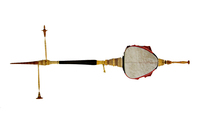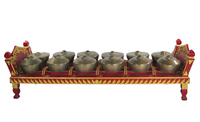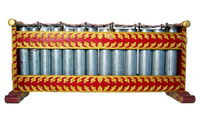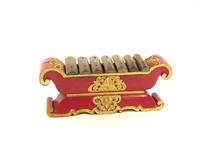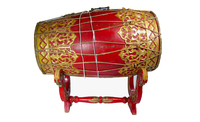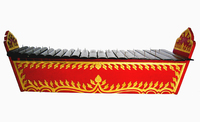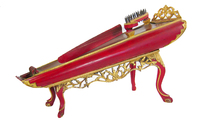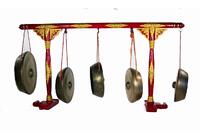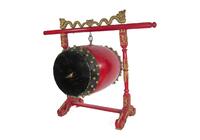Javanese Gamelan
Title
Javanese Gamelan
Description
Gamelan is an ensemble consisting of predominantly metallophone and gong type instruments. The instruments produce tones when struck with mallets. The ensemble, in various sizes and forms, can be found in a number of Indonesian islands. In Java and Bali, gamelan has developed into an expansive ensemble, while a variety of smaller ensembles continue to exist. In Java alone, there exist several forms of gamelan ensembles. There are two especially known main gamelan styles: Sundanese (West Javanese) and Javanese gamelan. The following descriptions focus on Central Javanese gamelan.
-----
INSTRUMENTS AND THEIR FUNCTIONS IN THE ENSEMBLE
Javanese gamelan ensemble is known for its expansive or grandeur ensemble, employing a rich variety of instrument types. In a full set of gamelan, beside metallophones and gongs, there are other types of instruments, including a set of drums (kendhang), bowed- and plucked-strings (rebab and celempung), xylophone (gambang), and a bamboo flute (suling). A “soloist” female singing (sindhen) and male chorus (gerong) are also present in the gamelan ensemble.
Each or a group of instruments and singing has a particular function in the ensemble, although there is a degree of flexibility. Generally the instruments may fall into the following three functional groupings: (1) instruments that delineate the structure of the piece; (2) instruments that guide temporal flow in the music; (3) and instruments that carries melodies in both simple and elaborate forms.
Instruments in the first category include large and medium hanging gongs (gong ageng and gong suwukan), small size hanging gongs (kempul), large standing gongs (kenong), and a pair of small standing gongs (kethuk-kempyang). The stroke of a large hanging gong marks the end of the main musical unit (gongan), while other gongs (kenong, kempul, and kethuk-kempyang, respectively) subdivide it in the order of its importance. Instruments in the second category are a set of two-headed drums (kendhang). The drumming style is defined by the use of particular kendhang or a combination of them. The drumming may consist of a repeatable, simple rhythmic configuration (kendhang satunggal and kendhang kalih) to elaborate and animated rhythm (kendhang ciblon) that are associated with dance movements.
The third category consists of three instrumental groupings: (a) instruments that carries melodic skeleton of the piece (balungan): saron, demung, and slenthem; (b) instruments that carries elaborate form of melodies, encompassing wide melodic registers (rebab, gambang, and singing), medium registers (gender barung) and narrow register (celempung, gender panerus, and suling). Generally, the wider their registers the more importance are their melodic functions; (3) instruments whose functions are to mediate between group a (balungan) and group b (elaborating instruments): bonang barung, bonang panerus, and peking. The anticipatory nature of the melodies of these instruments (especially bonang barung) has earned them the status of melodic guidance of the ensemble.
Gamelan instruments can also be grouped according to the volume of the sound they can produced: soft-sounding and loud-sounding instruments. The soft-sounding instrument are positioned in the middle- and side-front to the middle row—rebab, gender, gambang, celempung, suling, slenthem—together with the singers. The loud-sounding instruments are in the side-front, middle, and back rows: bonang, kendhang, a group of saron, ketuk-kempyang, kenong, kempul, gong. Soft-loud category is an important basis for the playing style of gamelan and the ensemble’s interplay.
-----
TUNING SYSTEM, PATHET, AND GENDHING
A full gamelan set employs two tuning systems, slendro and pelog (thus, the full gamelan is actually a double sets, with the slendro set usually facing to the front and the pelog set to the side). The two sets are never played simultaneously, however. The slendro tuning consists of five notes per octave. The five intervals consist of short and medium steps. The difference between the two intervals is so small, however, that they are often described as equal or nearly equal intervals. The pelog has seven pitches per octave (1 2 3 4 5 6 7), but a gendhing is composed on the basis of the combination of sets of five pitch positions (1 2 3 5 6; 1 2 4 5 6; 2 3 5 6 7). In this sense, pelog is a pentatonic system, employing not only one but three basic five-pitch scales. Unlike slendro, narrow and wide intervals in each of these scales are apparent.
Another musical concept associated with tuning system is modal classification called pathet. It is a system of the hierarchical use of tones (and/or different use of scale degrees, especially in pelog), supported by characteristics of instruments or vocal idioms to be used to approach these tones and the register of the tones used in composition. Pathet circumscribes general mood or emotive content of a composition. There are three pathet in each of the tuning systems.
Composition in gamelan (gendhing) is determined and arranged by a number of parameters. First, a gendhing is composed in a particular tuning system and pathet. Secondly, a composition is framed in one of the formal structures (gongan). There are a docent formal structures defined in binary way by the stroke of gong, kenong, kempul, and kethuk. Thirdly, the melodies of gendhing are arranged in a metrical unit of four notes (gatra).
-----
PERFORMANCE CONTEXTS AND HISTORY
Gamelan may be performed independently, i.e., to be listened for its own sake. But gamelan is also an essential accompaniment for theatrical performances, such as dance drama and shadow wayang puppet play. Whether accompanying theatrical forms or not, gamelan is performed in several different contexts, especially in rite-of passages events and communal festivals. As history and technology advance, other contexts are created, including gamelan performance on radio and television stations.
From little historical evidence we could find, it is safe to say that smaller ensembles, whether they accompanied singing or not, characterized music ensembles during the early period of Javanese history. In the 16th to 17th century, the ensemble began to develop into larger size. This was achieved by synchronizing loud- and soft-sounding instruments and vocal repertoire into an integrated musical concept. The result was an expansive size of ensemble with its hundreds of repertoire as can be found in today’s gamelan and gamelan practice.
-----
INSTRUMENTS AND THEIR FUNCTIONS IN THE ENSEMBLE
Javanese gamelan ensemble is known for its expansive or grandeur ensemble, employing a rich variety of instrument types. In a full set of gamelan, beside metallophones and gongs, there are other types of instruments, including a set of drums (kendhang), bowed- and plucked-strings (rebab and celempung), xylophone (gambang), and a bamboo flute (suling). A “soloist” female singing (sindhen) and male chorus (gerong) are also present in the gamelan ensemble.
Each or a group of instruments and singing has a particular function in the ensemble, although there is a degree of flexibility. Generally the instruments may fall into the following three functional groupings: (1) instruments that delineate the structure of the piece; (2) instruments that guide temporal flow in the music; (3) and instruments that carries melodies in both simple and elaborate forms.
Instruments in the first category include large and medium hanging gongs (gong ageng and gong suwukan), small size hanging gongs (kempul), large standing gongs (kenong), and a pair of small standing gongs (kethuk-kempyang). The stroke of a large hanging gong marks the end of the main musical unit (gongan), while other gongs (kenong, kempul, and kethuk-kempyang, respectively) subdivide it in the order of its importance. Instruments in the second category are a set of two-headed drums (kendhang). The drumming style is defined by the use of particular kendhang or a combination of them. The drumming may consist of a repeatable, simple rhythmic configuration (kendhang satunggal and kendhang kalih) to elaborate and animated rhythm (kendhang ciblon) that are associated with dance movements.
The third category consists of three instrumental groupings: (a) instruments that carries melodic skeleton of the piece (balungan): saron, demung, and slenthem; (b) instruments that carries elaborate form of melodies, encompassing wide melodic registers (rebab, gambang, and singing), medium registers (gender barung) and narrow register (celempung, gender panerus, and suling). Generally, the wider their registers the more importance are their melodic functions; (3) instruments whose functions are to mediate between group a (balungan) and group b (elaborating instruments): bonang barung, bonang panerus, and peking. The anticipatory nature of the melodies of these instruments (especially bonang barung) has earned them the status of melodic guidance of the ensemble.
Gamelan instruments can also be grouped according to the volume of the sound they can produced: soft-sounding and loud-sounding instruments. The soft-sounding instrument are positioned in the middle- and side-front to the middle row—rebab, gender, gambang, celempung, suling, slenthem—together with the singers. The loud-sounding instruments are in the side-front, middle, and back rows: bonang, kendhang, a group of saron, ketuk-kempyang, kenong, kempul, gong. Soft-loud category is an important basis for the playing style of gamelan and the ensemble’s interplay.
-----
TUNING SYSTEM, PATHET, AND GENDHING
A full gamelan set employs two tuning systems, slendro and pelog (thus, the full gamelan is actually a double sets, with the slendro set usually facing to the front and the pelog set to the side). The two sets are never played simultaneously, however. The slendro tuning consists of five notes per octave. The five intervals consist of short and medium steps. The difference between the two intervals is so small, however, that they are often described as equal or nearly equal intervals. The pelog has seven pitches per octave (1 2 3 4 5 6 7), but a gendhing is composed on the basis of the combination of sets of five pitch positions (1 2 3 5 6; 1 2 4 5 6; 2 3 5 6 7). In this sense, pelog is a pentatonic system, employing not only one but three basic five-pitch scales. Unlike slendro, narrow and wide intervals in each of these scales are apparent.
Another musical concept associated with tuning system is modal classification called pathet. It is a system of the hierarchical use of tones (and/or different use of scale degrees, especially in pelog), supported by characteristics of instruments or vocal idioms to be used to approach these tones and the register of the tones used in composition. Pathet circumscribes general mood or emotive content of a composition. There are three pathet in each of the tuning systems.
Composition in gamelan (gendhing) is determined and arranged by a number of parameters. First, a gendhing is composed in a particular tuning system and pathet. Secondly, a composition is framed in one of the formal structures (gongan). There are a docent formal structures defined in binary way by the stroke of gong, kenong, kempul, and kethuk. Thirdly, the melodies of gendhing are arranged in a metrical unit of four notes (gatra).
-----
PERFORMANCE CONTEXTS AND HISTORY
Gamelan may be performed independently, i.e., to be listened for its own sake. But gamelan is also an essential accompaniment for theatrical performances, such as dance drama and shadow wayang puppet play. Whether accompanying theatrical forms or not, gamelan is performed in several different contexts, especially in rite-of passages events and communal festivals. As history and technology advance, other contexts are created, including gamelan performance on radio and television stations.
From little historical evidence we could find, it is safe to say that smaller ensembles, whether they accompanied singing or not, characterized music ensembles during the early period of Javanese history. In the 16th to 17th century, the ensemble began to develop into larger size. This was achieved by synchronizing loud- and soft-sounding instruments and vocal repertoire into an integrated musical concept. The result was an expansive size of ensemble with its hundreds of repertoire as can be found in today’s gamelan and gamelan practice.
Contributor
Sumarsam (2004)
